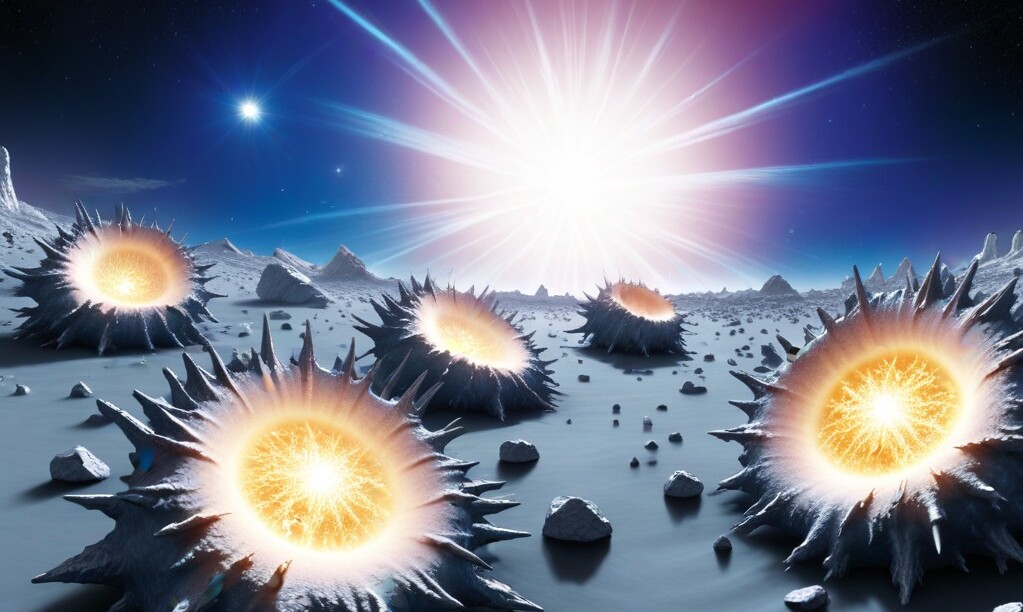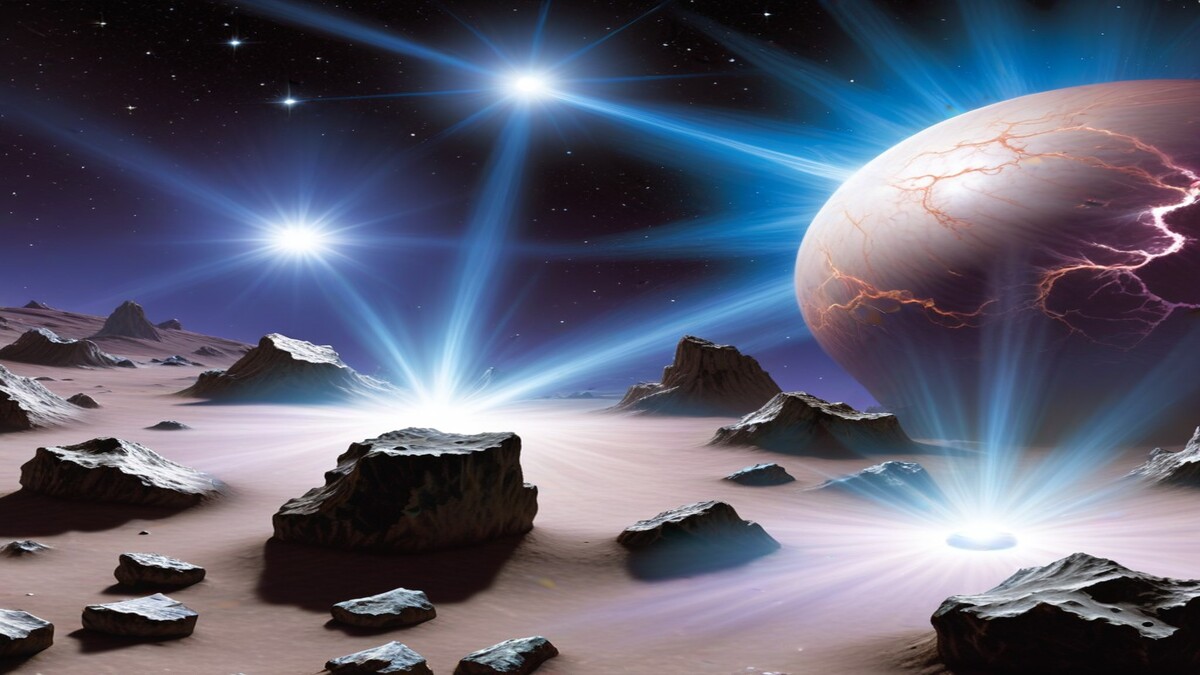White Dwarf Stars: Our galaxy is filled with celestial graveyards, remnants of once-mighty stars. Among them are white dwarfs, the incredibly dense cores of Sun-like stars that have exhausted their fuel. But these seemingly dead stars harbor a secret: they have a taste for heavy metals!
For years, astronomers have puzzled over the presence of elements like silicon, magnesium, and calcium on white dwarf surfaces. These heavy metals should sink rapidly towards the core in such a dense environment. But new research suggests a surprising explanation – white dwarfs might be actively “eating” nearby asteroids and comets, a process fueled by a powerful “natal kick” during their formation.

White Dwarf Stars: A Stellar Feast
Imagine a star the size of Earth, but with the mass of our Sun. That’s a white dwarf! These compact giants are the endpoint for most stars, and their composition offers valuable clues about stellar evolution. However, the presence of heavy metals on their surfaces defied conventional understanding.
“Normally, these metals would sink to the core very quickly,” explains lead author Tatsuya Akiba, a graduate student at the University of Colorado Boulder. “So, finding them on the surface suggests the white dwarf must be actively accreting, or consuming, material from its surroundings.”
This “material” could be asteroids, comets, or other small celestial bodies collectively called planetesimals. By studying white dwarfs’ interactions with these cosmic morsels, astronomers hope to unlock the secrets of their metallic diet.
The Natal Kick: A Recipe for Cosmic Collisions
Recent research proposes a fascinating explanation for how white dwarfs acquire their heavy metal meals. Scientists believe that during their formation, white dwarfs experience a “natal kick” – a powerful jolt due to asymmetric mass loss. This kick might play a crucial role in stirring up the surrounding debris field, setting the stage for a cosmic feeding frenzy.
Using computer simulations, researchers found that the natal kick can elongate and align the orbits of nearby planetesimals. This makes them more susceptible to being pulled in by the white dwarf’s gravity, leading to a steady stream of heavy metal-rich snacks.
A Long-Lasting Feast: Millions of Years in the Making
The simulations also revealed a surprising detail. The elongated orbits, once established, persist for millions of years. This explains why white dwarfs can continue to consume planetesimals over vast stretches of time, ensuring a constant influx of heavy metals.
“This is what makes our theory unique,” says senior author Anne-Marie Madigan, an astrophysicist at CU Boulder. “It explains the long-lasting nature of these accretion events, offering a solution to the mystery of heavy metals on white dwarf surfaces.”
Beyond White Dwarfs: Implications for Solar System Evolution
The implications of this research extend far beyond white dwarfs themselves. These findings shed light on the broader processes of solar system evolution and the complex distribution of elements within our galaxy.
“Most planets will eventually find themselves orbiting a white dwarf,” explains Madigan. “Our study suggests that up to half of these systems might be consumed by their star, including our own solar system in the distant future. Now, we have a mechanism to understand why.”
White Dwarfs: A Window into the Cosmos
Studying white dwarfs isn’t just about the past; it’s also about the future. As co-author Sarah McIntyre, an undergraduate student at CU Boulder, points out, “Planetesimals around white dwarfs can offer insights into other solar systems and planetary compositions beyond our own. White dwarfs are a lens not just into the past, but also the future of our universe.”
More About White Dwarf Stars
Formation: When a Sun-like star exhausts its fuel, it sheds its outer layers, leaving behind a hot, dense core – the white dwarf.
Composition: Primarily composed of carbon and oxygen, leftovers from the star’s earlier fusion processes.
Fate: White dwarfs gradually cool down over billions of years, eventually becoming black dwarfs (though the universe isn’t old enough for any to exist yet).
Importance: White dwarfs play a crucial role in understanding stellar evolution and are involved in exotic phenomena like Type Ia supernovae.
FAQs: Hungry White Dwarfs
- How hot are white dwarfs?
White dwarfs have extremely hot surfaces, reaching millions of degrees Kelvin initially. However, they cool down over time.
- What is a black dwarf stars?
A black dwarf is the theoretical endpoint of a white dwarf. It’s a cold, dark remnant of a star that no longer emits any significant heat or light.
- Can white dwarf stars explode?
Yes, under specific circumstances. If a white dwarf accretes matter from a companion star and exceeds a certain mass limit (known as the Chandrasekhar limit), it can trigger a thermonuclear runaway reaction, resulting in a Type Ia supernova – a colossal explosion.
- How common are white dwarf stars?
White dwarfs are the most common type of star in our galaxy. Estimates suggest they make up roughly 97% of all stars.
- Will our Sun become white dwarf stars?
Yes, our Sun is destined to become a white dwarf in billions of years. It will exhaust its hydrogen fuel, shed its outer layers, and leave behind a hot, dense core.
- Can white dwarfs have planets?
It’s possible, although the concept is still being explored. Any planets orbiting a white dwarf would likely be tidally locked, meaning they would always present the same side to the star.
- How do astronomers study white dwarf stars?
Astronomers use telescopes to analyze the light emitted by white dwarfs. This light reveals information about the star’s composition, temperature, and other properties.
- What are the applications of studying white dwarf stars?
Understanding white dwarfs helps us comprehend stellar evolution, the fate of stars, and the distribution of elements in the universe. They also serve as crucial tools for measuring cosmic distances.
- What are the future directions of research on white dwarfs?
Future research will focus on refining our understanding of white dwarf interactions with surrounding material, exploring the possibility of planetary systems around white dwarfs, and leveraging them for even more precise measurements of the cosmos.
- Are there any ongoing space missions studying white dwarfs?
Yes, several space telescopes like Hubble and Gaia are observing white dwarfs. Additionally, future missions like the James Webb Space Telescope might provide even deeper insights into these fascinating stellar remnants.
Credit:
https://www.earth.com/news/hungry-white-dwarf-stars-eat-heavy-metals/
The study is published in The Astrophysical Journal Letters.





